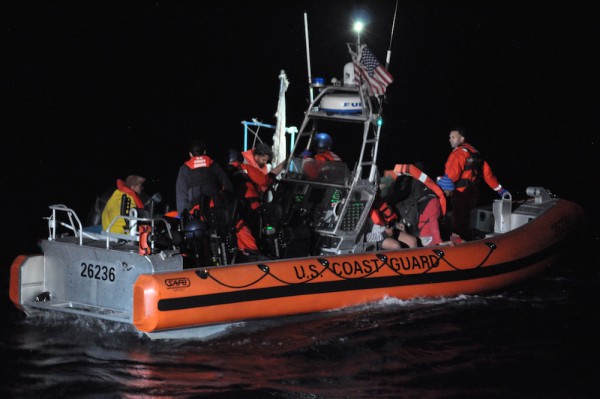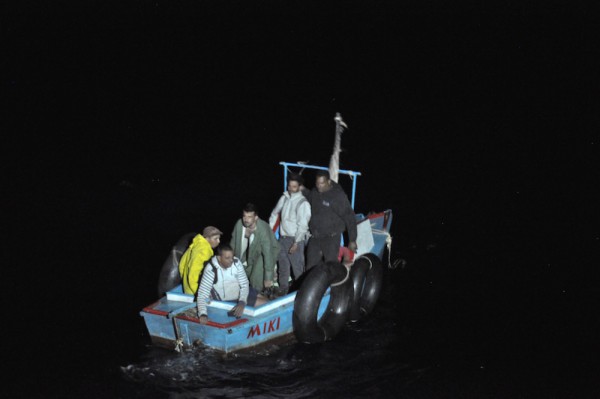Gene Machine migrant rescue: The captain's story
On Friday 26 February, superyacht Gene Machine encountered a raft of Cuban migrants without life jackets, and aided the US Coast Guard their rescue. Here, the yacht's captain, Fraser Gow, tells the story from his eyes.…
On Friday (26 February, 2016), approximately 30nm off Miami, 55m superyacht Gene Machine (ex-Engelberg) was on its way to St. Thomas from Dania Cut shipyard when it encountered six Cuban migrants in darkness, without lifejackets, in distress. The superyacht’s captain radioed the US Coast Guard and provided them with water and reassurance until the US Coast Guard arrived nearly an hour and a half later. Here, in his own words, the captain, Fraser Gow, talks us through exactly what happened and the moral dilemma he faced.
On Friday afternoon, Gene Machine departed Dania Cut shipyard, bound for St. Thomas. As we exited Port Everglades it was clear the northerly wind that was fighting the gulf stream was kicking up a significant seaway, so rather than heading out for a miserable slog south I altered our passage plan in order to hug the coast down past Miami. If we had stuck with our original passage plan, I would imagine this story would have played out very differently.
They informed us they had broken down and had been adrift for six days; they had seen multiple vessels pass but non had stopped to render assistance.
I handed over the watch and proceeded to my office to work on the itinerary for our upcoming trip. At 19:30 I was called to the bridge by our first officer Jesse, who informed me they had spotted a strange light off our port bow. I quickly picked up a set of binoculars; unsure of what the light was, I gave the go-ahead to alter course and investigate. As we approached to within ear shot nothing was heard, no waving arms, no obvious signs of distress. Normally I am very apprehensive about getting too close to other people and bothering, them especially in crowded anchorages, however this still didn’t look right. We lit them up with our spotlights and zoned in our FLIR camera on the small craft, and counted six adult males, non of whom were wearing life jackets. We continued to close the gap and about 20m off our deckhand Nick called out and asked if they were ok. At this point they began shouting and asking for help. They informed us they had broken down and had been adrift for six days; they had seen multiple vessels pass but non had stopped to render assistance. Their form of attracting attention was fairly crude; it appeared to be a tight bunch of twigs soaked in something to help it burn – nowhere near as distinct and obvious as a red flare.
At this point I notified the US Coast Guard Sector Miami on VHF Ch.16, giving them our situation report, our position and our vessel’s details. They dispatched two Coast Guard vessels to our location and asked how long we could remain on station. Not wanting to leave these guys alone in the dark again, we informed the Coast Guard that we would remain on station until their units arrived. It was at this point my moral dilemma started. I’m standing 6m above the water on the wing station of a multi-million dollar superyacht with our search lights trained on them and have just crushed any hopes they had of making it to the shores of Florida by calling the Coast Guard. On the other hand, myself and my crew have potentially saved their lives by reporting them. During recent summers in the Mediterranean I’ve often wondered what action I would take should I come across any of the thousands of migrants fleeing to Europe. My naivety had led me to assume Cuba, under the new regime of Raul Castro and the recent ease of sanctions, would result in less Cubans attempting to flee the country.
I’m standing 6m above the water on the wing station of a multi-million dollar superyacht with our search lights trained on them and have just crushed any hopes they had of making it to the shores of Florida by calling the Coast Guard.
What to do now? The first course of action was to get them fresh water. We circled around and positioned them roughly three meters off our port side, where my crew were able to throw them bottles of water. A few landed in the water but several were on target. At this distance we made it clear we were not prepared to have them board us and they should remain on their boat, as assistance was coming. This wasn’t really what they wanted to hear, as they knew that once the Coast Guard arrived they would be picked up and shipped back to Cuba. They were a mere 24nm from the coast and all they wanted was a tow. (The US continues to operate a “Wet foot, dry foot” policy, which stipulates if a Cuban national is stopped before setting both feet ashore on US soil they are to be sent back to Cuba or a third-party country, while those who plant both their feet on dry land are allowed to stay.) We continued to orbit around the small craft with our spotlights on them and our stabilisers working overtime to keep us from rolling in the swell. They continued to beg for a tow and pleaded for us not to leave them. I had no intention of taking off but I did open the distance between us as we were still towing our 38ft tender and I was worried I might tangle us all up in a mess. An hour and twenty minutes later, a 110ft Coast Guard cutter was on scene. They launched their RIB and manoeuvred themselves alongside the Cubans’ wooden craft, passed them life jackets and began to transfer them over to their RIB. At this point the Coast Guard radioed to inform us our further assistance was not required and we could continue our passage. As we got underway, several of the men, clearly defeated and disheartened, raised a hand in an effort to show their gratitude.
In a day an age where it’s all too common to throw the yacht on auto pilot and get distracted by fancy displays and readouts in the bridge, this is yet another experience that has re-instilled the need for everyone to pay attention to what is actually happening outside, look up from their smart phone and regularly scan the horizon for traffic, navigational hazards and potentially persons or vessels in distress.
Click here to become part of The Superyacht Group community, and join us in our mission to make this industry accessible to all, and prosperous for the long-term. We are offering access to the superyacht industry’s most comprehensive and longstanding archive of business-critical information, as well as a comprehensive, real-time superyacht fleet database, for just £10 per month, because we are One Industry with One Mission. Sign up here.






